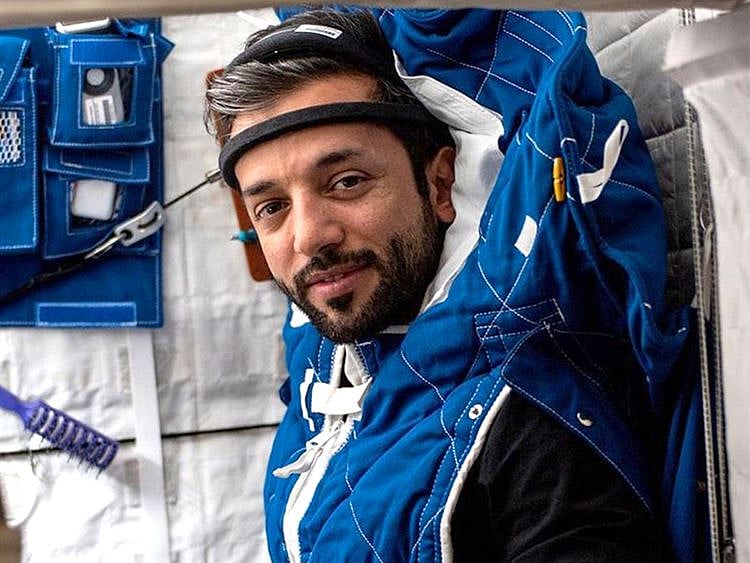Video: UAE astronaut Sultan Al Neyadi completes ‘Dreams’ sleep study
Sultan of Space shares stunning time-lapse video of 16 sunrises, sunsets from ISS

Dubai: The Mohammed Bin Rashid Space Centre (MBRSC) on Sunday announced the successful execution of the ‘Dreams’ experiment by astronaut Sultan Al Neyadi on the International Space Station (ISS). The experiment, a pivotal achievement in sleep science and space research, was conducted in collaboration with the European Space Agency (ESA), the French space agency CNES, and Toulouse University Hospital.
The Dreams experiment employs the innovative DRY EEG system to investigate the sleep patterns of astronauts in the microgravity environment on the ISS. Al Neyadi, who is on the longest Arab space mission under wore a specially designed sleep headband equipped with an electroencephalogram sensor. This device captures a range of sleep-related data, such as sleep cycle durations and heart rate variations.
Also Read
Watch: UAE astronaut Sultan Al Neyadi completes 4 months in space, invites questions from followersVideo: How do you shave in space? UAE astronaut Sultan Al Neyadi shows us howLook: Yoga in space by UAE astronaut Sultan Al Neyadi on International Day of YogaUAE astronaut Sultan Al Neyadi advances cardiovascular research with PCG experiment on International Space StationReflecting on the experiment, Adnan AlRais, Mission Manager, UAE Astronaut Programme, said: “This project, in partnership with ESA, CNES and Toulouse University Hospital, symbolises a crucial step forward in our understanding of the human body’s adaptability in space. The knowledge we gain here is instrumental to the success of future long-duration space missions, including trips to the Moon and Mars. We are incredibly proud of the contributions made by the UAE towards the international space community.”
Impact on circadian rhythm
Sébastien Barde, associate director for Exploration and Human Spaceflight (CNES) said: “In addition to being a cutting-edge scientific laboratory, the ISS is also a place for international cooperation. For ESA astronaut Thomas Pesquet’s Alpha mission, the Dream experiment was developed and monitored by CADMOS as part of the French contribution. CNES is delighted that this experiment is being continued with astronaut Sultan Al Neyadi. Science knows no frontiers, as this example clearly illustrates.”
The impact of space travel on the circadian rhythms of astronauts is a crucial area of investigation for the Dreams experiment. The unique conditions aboard the ISS, where astronauts witness 16 sunrises and sunsets each day, disrupt the natural day-night cycle, significantly affecting sleep patterns. This study is intended to deliver key insights that will assist in planning and developing cognitive therapies for astronauts to improve sleep quality and overall health during extended space missions.
The outcomes of this experiment will add to the collection of hypnic and neuroscience data on the ISS, which will be studied by the scientific community. The experiment exemplifies MBRSC’s commitment to advancing the understanding of challenges and complexities of human space exploration.
16 sunsets, 16 sunrises
Meanwhile, Al Neyadi on Saturday shared a stunning video that captures the flashing sunsets and sunsets in a day as the ISS completes one revolution of Earth in 90 minutes. at a speed of 28,000km/hour.
“Sunset, then sunrise, then sunset... Every day, we witness 16 sunrises and sunsets aboard the ISS.Sharing with you this time-lapse video, captured from an altitude of around 400 km above Earth,” he said in the social media post.
Al Neyadi also asked his followers to guess the names of some of the countries that appear in the video.
On Sunday, the Sultan of Space also shared images of him using the Multi-use Variable-g Platform.
Al Neyadi explained that the platform allows astronauts to conduct experiments on plants, cells, protein crystals and others, with the ability to simulate up to two times the force of gravity. “These experiments can help study the behaviour and growth of organisms,” he added.
The UAE Astronaut Programme is one of the projects managed by MBRSC under the UAE’s National Space Programme. Funded by the ICT Fund of the Telecommunications and Digital Government Regulatory Authority (TDRA), it aims to support research and development in the ICT sector in the UAE and raise the country’s profile on the global stage.
Sign up for the Daily Briefing
Get the latest news and updates straight to your inbox
Network Links
GN StoreDownload our app
© Al Nisr Publishing LLC 2025. All rights reserved.